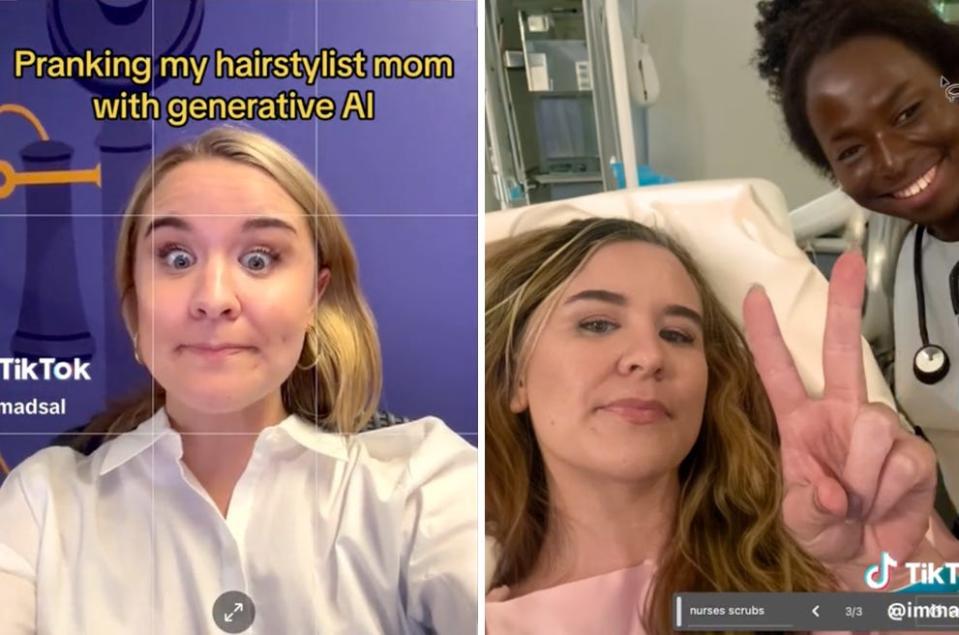A woman's experiment with generative AI to fake thirst traps and doctored photos to get out of plans has been called both 'brilliant' and 'scary'

Madeline Salazar has been playing with Adobe's generative AI tools to create fake images.
She's sharing some of her best work on TikTok, pranking her family and faking thirst trap photos.
TikTok users are both impressed with her work, and "scared" of what the future holds.
TikToker Madeline Salazar is expanding our use of generative AI — in hilarious, creative, and concerning ways.
Over the past week, Salazar, who's a digital content producer based in New York City, has been sharing ideas to use the technology to prank her family and show users how they can doctor images to get out of plans or take a sexy photo to send to a crush without moving from the couch.
Despite widespread cynicism for AI, especially from commenters on her most viral posts, Salazar, 29, told Insider she hopes to "inspire creativity" and not scare people away from artificial intelligence.
Salazar began her series last week when she posted a video about pranking her mom, making her think she'd dyed her hair. In the TikTok, which has been viewed 1.8 million times, Salazar uses Adobe's generative AI tools to fake photos of herself in the salon chair, getting her hair washed, and even a bathroom selfie of her new transformed hair.
@immadsal If I could do this over again I’d have sent one of the perms #generativeai #adobephotoshop #adobeai #photoshopai #ai #aiprank ♬ Jackass - TV Theme Players
The prank was so successful that her mom, a professional hair stylist herself, believed the images her daughter sent over text. "I hadn't seen anyone pull pranks with the technology yet," Salazar told Insider about her first stunt. She said she also successfully pulled a prank on her friends that she got tattoos (though she didn't post that one publicly).
The TikTok community was as impressed as it was baffled. "The future is scary" and "AI about to change the gaslighting game," are some of the top comments on the post.
The next day, Salazar posted her most viral generative AI hack. Using the same program, she showed viewers how she's "about to photoshop my way out of any and every plan," she captioned the TikTok.
The digital content producer responded to a text that read "Are you still coming to help me move?" with a doctored image of herself on a hospital bed, complete with a hospital bracelet and an AI-generated nurse smiling behind her. "No :(" she wrote back, attaching the fake image. That video has been watched nearly 7 million times.
@immadsal Replying to @Xavier Jacob Morris about to photoshop my way out of any and every plan #generativeai #adobephotoshop #adobeai #photoshopai #ai #aiprank ♬ Feral Anthems pt 4 - DJ L BEATS
Commenters were amused by this clever hack to get out of plans. "Brilliant," someone wrote. "Oh I might 'miss' school tomorrow," another added.
However, many people said they're threatened by how crafty and realistic these images are. And that it's setting a "scary" new standard for the future.
"Everything is a lie. I have no reason to trust anybody ever again," a top comment, with 11,400 likes, said. "That is crazy...what is real anymore," another person weighed in.
Salazar told Insider these fake images can take up to 40 minutes to make, depending on how smart her AI is, and how much data she still needs to feed it. "There are plenty of additional adjustments I make with standard photoshopping methods," she said.
Salazar said she's shocked that so many people have come away from her TikToks more fearful and cynical about AI. She feels more optimistic about the technology and is constantly thinking about inventive ways people and brands can use it.
"It could be a great way for clothing designers to brainstorm new concepts, for writers to create characters and worlds, and for graphic designers to level up their craft," she said.
She also wants viewers to know that these are low-stakes deceptions and are for laughs. "I wouldn't feel comfortable creating deepfakes, or making deceitful images where someone other than myself was the subject," she said. "There are plenty of malicious ways that people could use AI to harm the reputation of others."
In one recent example, Salazar turned a photo of herself lying in bed with no makeup on into a typical thirst trap someone might send a romantic interest.
@immadsal Replying to @🌻 When he asks for a selfie but you be lookin rough 😮💨 #generativeai #adobeai #photoshopai #ai #aifails #thirsttrapchallenge #thirsttrap #aithirsttrap ♬ edamame - bbno$
As people are alarmed by AI tools like this and ChatGPT, the industry is on track to grow into revenues upwards of $1.3 trillion over the next 10 years, according to a report from Bloomberg Intelligence. Media and advertising companies are openly adopting these features to do tasks that were traditionally done manually and by a human. Ironically, job listings for AI skills are also on the rise.
Adopters like Salazar want people to know that the future shouldn't be scary — if AI is used responsibly and practically.
"I am so surprised how many people don't realize how cool this technology is," she told Insider. "We will adapt with it the same way we have evolved with technological advancements for thousands of years. There's no way to fight against it, so try to learn about it and embrace it."
Read the original article on Insider

 money
money 